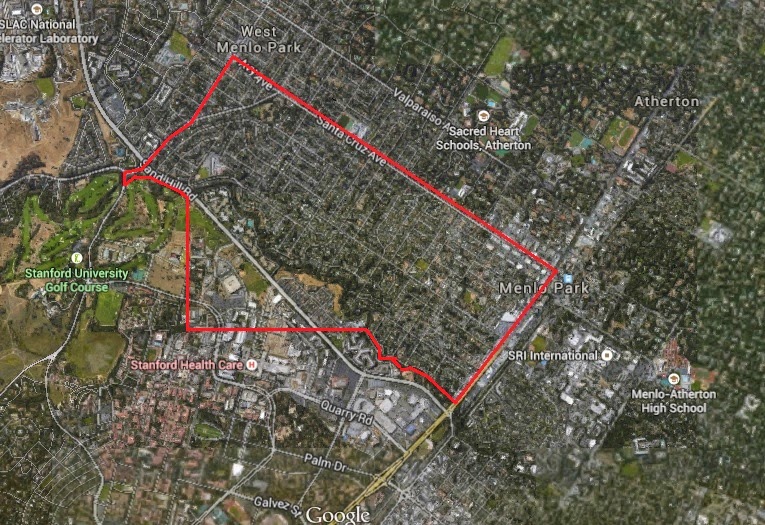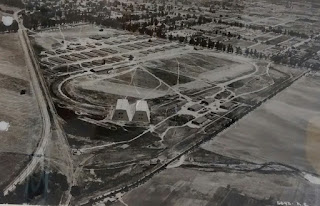Los Angeles County:
Ross Field was 186 acres in size and was used as a balloon field.
It saw some use as a civil airport up until the 1930s.
It saw some use as a civil airport up until the 1930s.
San Pedro:
Ft. McArthur  |
| Fort MacArthur circa 1923. |
San Pedro Naval Station
Submarines showed up in 1913. Battleships arrived in 1919. It appears this was a short lived base until the much larger Long Beach (Roosevelt) station was construction for WWII.
The presidio was seized during the Mexican-American War in 1846. In 1917, there was 15,609.5 acres acquired for a rifled range at what would be called Camp Gigling, and eventually Fort Ord.
The POM lives on as the Defense Language Institute. But Fort Ord closed in fall of 1994. Yours truly was a pioneer student at CSU Monterey Bay, which would open in Fall 1995.
Riverside:
 |
| Area in red represents March Field circa 1918. The rest of the base circa 1993 before partial closure. |
 |
| Circa 1919 |
 | |||
| A model of how March looked in 1918 is on display at the March Air Force Base Museum. |
 |
| Circa 1918. |
March Field started off with a mere 640 acres. There might be one original WWI era building left on what is now March Air Reserve Base. The original runway was located in what is now a historical housing area (built in the 1930s.) Before partial base closure or realignment in 1993, March was as large as 6600 acres! Today the 2200 acre reserve base has a sizeable military reserve and National Guard presence, and it boasts a 13,000 foot runway.
Sacramento: | ||
| Area in red is Mather Field circa 1918. The rest of area is circa 1993 before base closure. |
 |
| Circa 1918. |
 |
| Sacramento parcels map circa 1920s. Mather Field would go on to become a much larger Air Force Base. Another early map of Mather Field |
Auxiliary Field #1:
The U.S. Govt. also leased about 160 acres during WWI. Researching auxiliary fields has been challenging as I can find no documentation on the exact location.
San Diego:
 |
| San Diego circa 1920s. The Naval Training Center is the only military base nonexistant during WWI. |
 |
| Camp Kearney "Hospital" |
Camp Kearny was one of 16 National Guard camps. After the war, the navy took it over for Miramar NAS which saw action during WWII and was the "Top Gun" pilot school.
Today, the base is now Miramar Marine Corps Air Station because the Marines got the boot from El Toro in the late 1990s. Rebecca Cox, (the wife of then Orange County congressman Chris Cox) voted to close the El Toro Marine Base in 1993, so that one of Cox's biggest contributors, The Irvine Company could inject thousands of houses inside the former 14,000 acre aviation buffer zone.
That relocation for the benefit of a developer has cost the taxpayers millions of dollars. Also, compared to El Toro, Miramar has far less military housing. As a result many Marines and Sailors are forced to live in Tijuana and commute, since rents in the San Diego area are among the highest in the nation!
North Island Naval Air Station
Rockwell Field
(Updated 11/11/18)

 |
| Circa 1921 |
(Updated 11/11/18)

 |
| Just before the Army vacated Rockwell. |

 |
| Rockwell Field is in the foreground, while North Island NAS is in the back by the bay. |
Rockwell Field was established in 1912 making it the oldest flight school in the nation. It was adjacent to North Island Naval Air Station, which was established in 1917. Both the army and navy wanted to have exclusive claim to the scenic field in Coronado, and were waiting for the other to leave. It was a protracted dispute that would eventually be settle by FDR in the 30s, who was a navy man, and sided with the Navy. The army took their planes and flew away to March Field. North Island NAS is still active, and is a highly desirable location for duty.
Rockwell Field also had two auxiliary fields.
Otaymesa Field:
It saw action in WWII as Brown Field NAS. After the war, it became a civilian airport, which is still in operation.
Ream Field:
It saw action during WWII as a naval air station. The navy still uses the base to train helicopter pilots.
San Diego Marine Corps Recruit Depot at Balboa Park
The Marines trained at Balboa Park, until the MCRD opened up next to Lindbergh Airport in 1921.
San Diego Naval Station
The naval base opened in 1918 and still active today.
It started off as a harbor defense post. Today the navy occupies the base. But there is a scenic area where one can see the most incredible views of the ocean and the bay.
San Francisco Bay Area:
San Francisco Bay Area:
 |
| Early 1900s map featuring Alacatraz, Fort Baker, Fort Mason, The Presidio, and Yerba Buena Island. |
Ft. Baker (Marin County)
Ft. Barry (San Francisco)
Atherton:
Camp Fremont
(Updated 10/11/18)
(Updated 10/11/18)
 |
| My crude attempt to show the boundaries of Camp Fremont main base. |
 |
| Postcard of Camp Fremont. |
 |
| Camp Fremont troops presenting at nearby Stanford Stadium before a football game. |
 |
| A map, circa 1918 showing Camp Fremont, and to the north, the hospital and remount depot. |
 | ||
| The hospital and remount depot were not contiguous with the main base. |
Camp Fremont was one of 16 National Guard tent camps. It was among the majority of National Guard camps that were short lived. The main post consisted of 1,203 acres and all the property was on 7,200 acres. Today, this prime real estate in the heart of Silicon Valley would be worth billions!
Camp Fremont hosted the 41st Infantry Division which consisted of
draftees from Oregon, Washington, Idaho, Montana, and Wyoming. It was designed for 30,000 troops, less than the average base due to work stoppages. In the middle of construction, there was a dispute with the state over the capacity of the sewage system, and work was abruptly halted in the summer of 1917, before there was a compromise. Incoming trainees were then diverted to Camp Greene, North Carolina. The signing of the Armistice put the final nail in the coffin of the troubled Camp Fremont.
It can never be said that the United States have ever had troops on Russian soil. A contingent of troops was Camp Fremont without a clearly defined mission were sent to Siberia during the Bolshevic Revolution. The troops, the Siberians, and the U.S. citizens were against the idea of the United States involvement. They eventually came home having served no real purpose in Siberia.
It can never be said that the United States have ever had troops on Russian soil. A contingent of troops was Camp Fremont without a clearly defined mission were sent to Siberia during the Bolshevic Revolution. The troops, the Siberians, and the U.S. citizens were against the idea of the United States involvement. They eventually came home having served no real purpose in Siberia.
The base lasted mere months and saw no WWII reuse. There is a Camp Fremont Park in the area. The former hospital now serves as the Palo Alto V.A. facility. Two camp buildings have survived. They now serve as the Oasis Beer Garden and the MacArthur Restaurant.
Ft. Funston (San Francisco)
Benicia:
Benicia Arsenal
Vallejo:
An early map of the hospital area.

Mare Island was founded in 1849 and lasted until it appeared on the 1993 base closure list.
Ft. Mason (San Francisco)

Mare Island was founded in 1849 and lasted until it appeared on the 1993 base closure list.
Ft. Mason (San Francisco)
Ft. McDowell (San Francisco)
Ft. Miley (San Francisco)
Presidio of San Francisco
The presidio was originally founded as a fortress for Spain in 1775. It was an active army base until it appeared on the 1988 base closure list. Today it as an absolutely stunning national park.
Letterman General Hospital (POSF)
Letterman was the largest general hospital of them all. The original configuration was demolished sometime in the 1970s to make way for a modern high rise still called Letterman Hospital. That too was demolished when it was too expensive to seismically retrofit it to meet California building codes for civilians.
Ft. William Scott (POSF)










































1 comment:
My uncle, Clarence Craft, was a teen in WW1. He died on a base in California" spanish flu", way out in the desert. Somewhere near the Nevada line. Clarence was apparently one of the first to join the Army in California. I've seen the base on a map but can't remember the name. I want to say camp owen but that is probably wrong.
Post a Comment